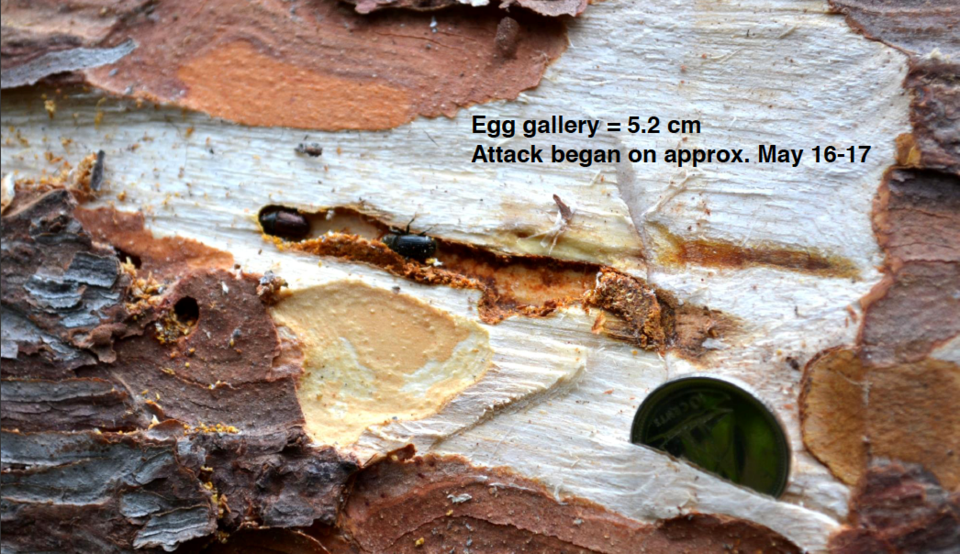Although the current spruce beetle outbreak has affected more than 1.3 million hectares of forest, much of it in the Prince George area during the past six years, the forest damage is still far less than what the mountain pine beetle did.
The mountain pine beetle epidemic has destroyed nine million hectares of forest in the past 20 years.
"We saw that peak in 2004 and it has slowly been tapering off but the mountain pine beetle is still very much around," Jeanne Robert, the regional forest entomologist for the Omineca and Northeast region, said.
Last year, the spruce beetle impacted more than 503,799 hectares across the province and more than half of that was in this area.
The Prince George district saw 259,629 hectares of forest destroyed by the spruce beetle while the toal Omineca Region, which includes Prince George, Fort St. James, Mackenzie, and Vanderhoof reported more than 354,000 hectares of damage.
"So you can see the difference in scale what we're talking about," Robert said. "It's a very large outbreak for spruce beetle but it is nothing compared to what we saw for mountain pine beetle."
It's important to remember that the mountain pine beetle, the Douglas fir beetle and the spruce beetle are all naturally occurring disturbances in the ecosystems that we have here, Robert added.
"So this isn't something that comes in and mows everything down," Robert added. "These forest ecosystems have evolved with the bark beetles and have some resilience when it comes to an outbreak like this."
There was a spruce beetle outbreak during the 1980s in the Bowron area southeast of Prince George and more recently significant infestations have occurred in Alaska, the Yukon and other parts of northern B.C.
"So these aren't crazy, off-the-charts occurrences, in fact we should expect regular outbreaks and we should manage for regular outbreaks of bark beetles as part of the natural process that happens in the ecosystem," Robert said.
The spruce beetle populations expand and contract over time, which makes it difficult to predict when an outbreak will occur.
There are many natural factors that determine when an outbreak will occur, including spruce tree size and age, and wind throw events where trees are uprooted because of strong winds. That is what has been determined to be the cause for the most recent spruce beetle infestation, Robert added.
"So if there's a storm and there's older trees that get blown over then that allows the spruce beetle to get established, get a toe hold and they move to standing healthy trees and that's exactly what happened to start things off," Robert said. "We had a big wind throw event north of Prince George and we had another one north of Mackenzie."
While there are many similarities, there are also significant different between the mountain pine beetle and the spruce beetle.
Both are bark beetles about the size of a grain of rice and they both reproduce actively in a single tree that can result in thousands of beetles.
One key difference is mountain pine beetle has a one-year life cycle where the spruce beetle is different.
"Sometimes it takes one year, most often two years and it can even take up to three years and it's really well adapted to a super-cold environment," Robert said.
Due to their longer life cycle, spruce beetles rarely attack young trees because there is not enough in them to sustain the beetles over their life cycle.
Spruce beetle infestation tends to be slow, intermittent and patchy, Robert added.
"The mountain pine beetle was sort of stopped by a cold-weather line that it then breached and moved into Alberta, which is one of the big things that happened with mountain pine beetle," Robert explained. "But what's different with spruce beetle is that it's already there. Where there is spruce trees, there is the beetle. They are very well adapted to live in very low population levels and in very cold environments."
Foresters find it difficult to predict what's going to happen from one year to the next when it comes to the spruce beetle because of its adaptability.
Damage is also hard to see from the air. Pine beetle could be seen as big red swaths from year to year while the spruce beetle's life cycle varies which means affected trees are not as quickly visible.
"It often takes a good 13 to 18 months after the original attack in a susceptible spruce stand for us to be able to detect it from the air as the tree starts to turn yellow, then red then gray," Robert said.
So detection can be quite challenging from the air and its been determined that ground assessment is best, which leads to treatment during the early stages of established infestations.
"Right now we're doing ground surveys, we're doing low level helicopter surveys trying to identify affected areas, get in there have a look to see where the beetle is getting established or where it might be dying down," Robert said.
Once this information is gathered, it is shared with timber supply area licencees so that work can be done to treat the area. One of the most affective ways to eliminate the infestation is to remove the trees, which minimizes the outbreak.
"These are all the things we are trying to do to grapple with the Spruce beetle outbreak," Robert said.
Leaving some infestation of Spruce stands is OK, too, since it eliminates the old Spruce, which allows room for the new Spruce to grow along with other species.
"It definitely does allow for new growth and the ecosystem will continue to thrive under those circumstances," Robert explained. "It isn't the end of the line, despite the fact it is a very large outbreak."



